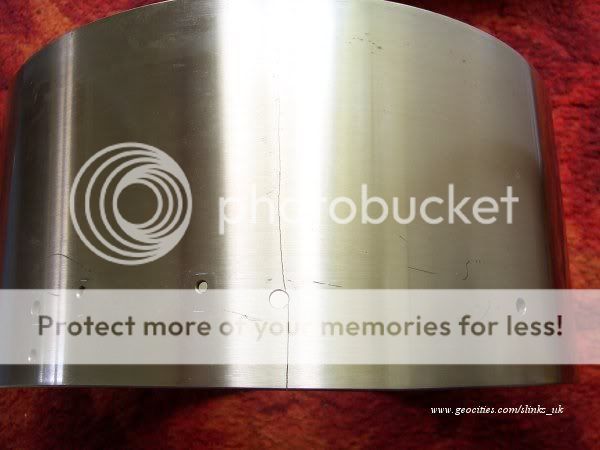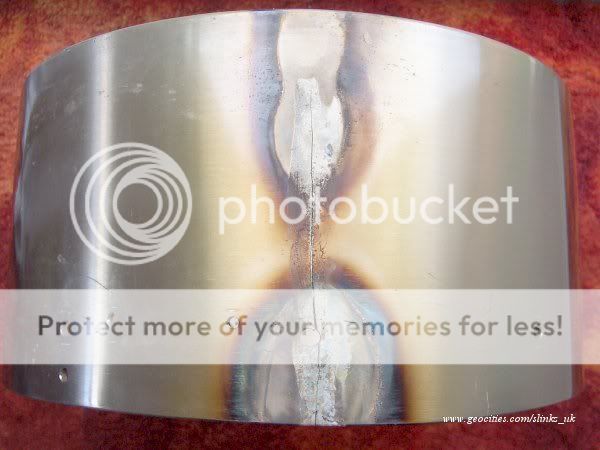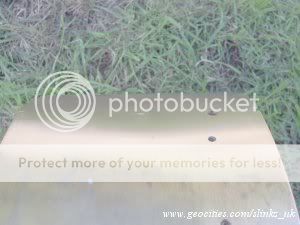

Sure enough sneaking along behind a tube lug was a big crack through the entire width of the shell wall and 2/3's of the drum depth. The tension rod on this lug was bent indicating an impact. The problem was not an impact with an object glancing into the box but the weight of the drum itself. Despite having some packaging in the box it arrived in (although in all fairness this should have been beefed up to suit the drum weight), the inertia of almost 20lbs of snare drum trying to suddenly stop on a tube lug nodal point had taken it's toll... time for a better look at the damage:

1.The most basic method would involve making a metal plate with the correct radius and drilling the shell carefully to fix it in place. This would have looked awful though.
2. Brazing was considered briefly but this would involve heating the shell to dangerous levels and possibily melting / warping it. Besides I think this would have killed off the tone once and for all.
3. Lastly soldering was considered, but what type of soldering? This question was answered for me by Joe Montineri, to whom I'd like to say thank you to for the info. He had actually seen a few of these fail right the way through the shell (I was even told about a few drastic cases where the shell had actually been smashed into several pieces by Gary at Noonan)! Here's Joe's solution via email:
Hi, I've repaired a few of these successfully. You need to have a jewellers torch, low temperature silver solder, + the correct liquid flux. Most importantly some torch + flux 'skills'. The result will be a silver looking hairline blem, if held together properly! Good Luck, Joe
I did consider doing this myself by practicing on a few cracked cymbals, but the drum shell is a lot thicker meaning it would be harder to heat up to the right temperature. In addition there is more than one type of jewellers blow torch and various types of silver solder! In the end I entrusted the work on the shell to a jeweller to get a nice result. Meanwhile it was time to examine the other parts. The black finish was rubbed off randomly on all the parts and it did look awful. Due to the shell damage a lot of the value was already gone so I decided the objective was now to go for a tidy looking player drum. I closely examined the Noble & Cooley black coating itself and it was obvious it had been applied to a normal chrome layer underneath so in keeping with the "what do I have to lose" philosophy I decided to take an educated guess and go for plain chrome. Now to remove the Black coat... after experimenting with different chrome cleaners I hit on a resonably aggressive one which wouldn't leave huge scratches like wire wool and such and lo and behold the coating started coming off fairly easily to my amazement! With a few hours to kill and some elbow grease here's the result of an experiment which I wouldn't usually dare attempt given the value of these drums:




Now it was all down to the jeweller to deliver the goods!

I made the decision to attempt the repair myself, things had hit rock bottom on this project and at least I could monitor things my way and work at my own pace. The first job was to make up a jig that would hold the shell in place effectively. I also had to factor that it needed to squeeze the shell back to round and allow it after heating and soldering to settle in the correct shape. There's no text book out there on the best method to repair these drum shells so it was simply a case of creating homemade tools as ideas presented themselves. With the help of my good mate Al and his impressive home workshop (from which many a project appears) we set upon building the external parts. We also figured we needed something to push against on the inside of the drum. Here's the result:



The solder did tend to run around a bit and in the picture the solder seam looks quite pronounced although it's actually fairly flat. I decided not to sand down the inside of the shell and leave it as it is for maximum strength. If the shell sounded too choked later on I'd always have the option of taking some solder off. There were still a few things to negotiate at this point and most of it was cosmetic. The first thing to do was to clean up the outside of shell, it was covered in oxidisation, flux and dripped through solder. This took hours of careful sanding by hand with a block, I avoided using machines to be sure I wasn't removing too much shell material, you can't replace it later on! What I ended up with was pretty much a silver line in the shell where the crack had been:



Above: By using a finer grade of wet and dry paper with a block and sanding in the same direction as the original machined grooves you can see the finish really coming back once the old lacquer and corrosion pits were removed.
Now I had everything mechanically lined up I took the shell off to spray a few coats of lacquer on. Afterwards I assembled the complete drum and added Puresound Blaster snare wires which worked very well. Here then is the finished drum after many hours of work, and a lot of trial and error:

Above: The toughest restoration project to date but well worth it!
You might be wondering how that crack in the shell cleaned up so here it is:

Above: A very small blemish which is hardly noticeable is the only clue from a close glance the drum has had some work.
The next stage was to tune the drum similarly to my other N&C Zildjian and check the difference in sound. I found that the unrepaired drum had slightly more ring but once they were both dampened down to normal usage levels the difference was almost undetectable, in short the drum sounded brilliant and sonically the repair was spot on! It was now time to dig out some decent competition and test the repaired drum against the best snare drums I have:

Above: Here are the drums used to check the sound quality, an original unrepaired N&C Zildjian, 1920's Heavyweight Brass, and a 70's Super Sensitive. The repaired drum kept up easily and was a total success.

